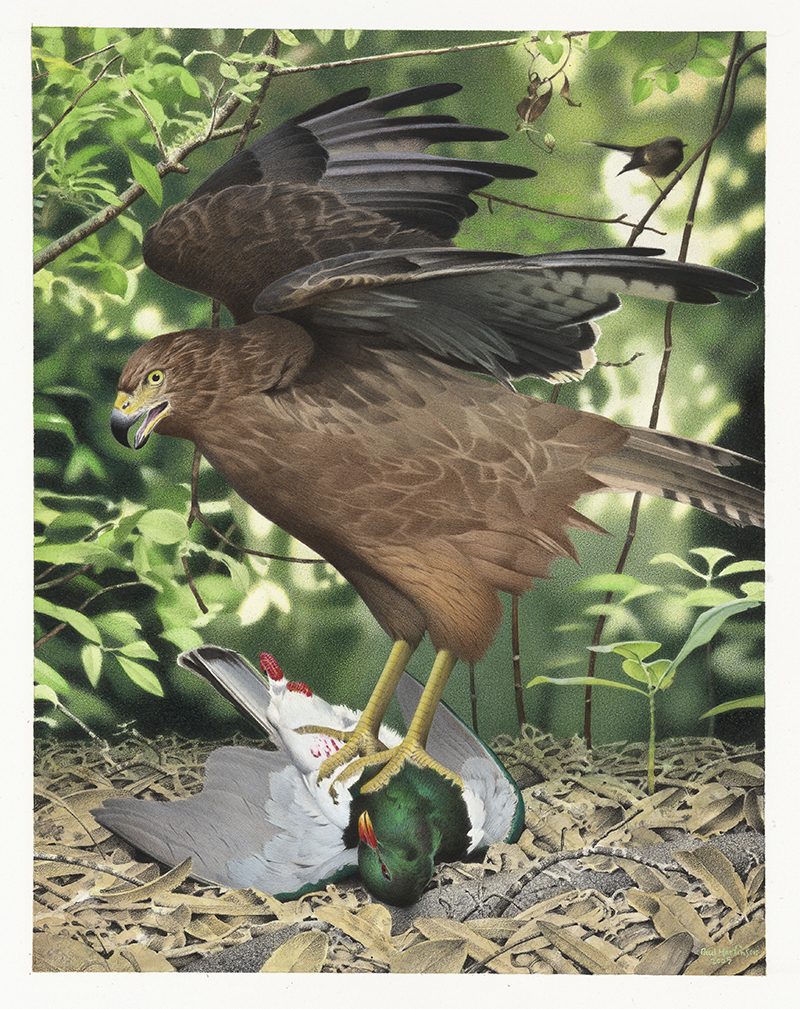Circus teauteensis Forbes, 1892:186
Eyles’ harrier, Large New Zealand harrier, Large N.Z. harrier, Forbes' harrier, Kērangi (Māori)
Taxonomy & Nomenclature
Previously considered a nomen dubium (Checklist Committee (OSNZ), 2022:184).
Conservation Status
Extinct
Last record: Holocene
Distribution
North Island, New Zealand
Biology & Ecology
Hypodigm
Media

Above: Forbes' Harrier. Circus teauteensis. From the series: Extinct Birds of New Zealand., 2005, Masterton, by Paul Martinson. Purchased 2006. © Te Papa. CC BY-NC-ND 4.0. Te Papa (2006-0010-1/35)
References
Original scientific description:
Forbes, H. O. (1892). Preliminary Notice of Additions to the Extinct Avifauna of New Zealand. Transactions and proceedings of the New Zealand Institute 24: 185-189.
Other references:
Checklist Committee (OSNZ). (2010). Checklist of the Birds of New Zealand, Norfolk and Macquarie Islands, and the Ross Dependency, Antarctica (4th ed.). Ornithological Society of New Zealand & Te Papa Press, Wellington. [p. 171]
Checklist Committee (OSNZ). (2022). Checklist of the Birds of New Zealand (5th edition). Ornithological Society of New Zealand Occasional Publication No. 1. Wellington: Ornithological Society of New Zealand. [p. 184]
Dawson, E. W. (1958). Re-discoveries of the New Zealand sub-fossil birds named by H. O. Forbes. Ibis 100: 232-237.
Hamilton, A. (1889). Notes on a deposit of moa-bones in the Te Aute Swamp, Hawke's Bay. Transactions and Proceedings of the New Zealand Institute 21: 311-318.
Holdaway, Richard N. and Worthy, Trevor H. (1997). A reappraisal of the late Quaternary fossil vertebrates of Pyramid Valley Swamp, North Canterbury, New Zealand. New Zealand Journal of Zoology 24(1): 69-121.
Holdaway, Richard N., Worthy, Trevor H. and Tennyson, Alan J. D. (2001). A working list of breeding bird species of the New Zealand region at first human contact. New Zealand Journal of Zoology 28: 119-187.
Hume, Julian Pender and Walters, Michael. (2012). Extinct Birds. London: T & AD Poyser.
Michael Knapp, Jessica E. Thomas, James Haile, Stefan Prost, Simon Y.W. Ho, Nicolas Dussex, Sophia Cameron-Christie, Olga Kardailsky, Ross Barnett, Michael Bunce, M. Thomas P. Gilbert, R. Paul Scofield. (2019). Mitogenomic evidence of close relationships between New Zealand’s extinct giant raptors and small-sized Australian sister-taxa, Molecular Phylogenetics and Evolution. doi.org/10.1016/j.ympev.2019.01.026 [Abstract]
Lambrecht, K. 1933. Handbuch der Palaeornithologie. Berlin: Verlag von Gebruder Borntraeger. xix + 1024 pp, 4 pls.
Robertson, H. A., Baird, K. A., Elliott, G. P., Hitchmough, R. A., McArthur, N. J., Makan, T. D., Miskelly, Colin M., O’Donnell, C. F. J., Sagar, P. M., Scofield, R. P., Taylor, G. A. and Michel, P. (2021). Conservation status of birds in Aotearoa New Zealand, 2021. New Zealand Threat Classification Series 36. Department of Conservation, Wellington. 43 pp.
Rothschild, Lionel Walter. (1907). Extinct birds: an attempt to write in one volume a short account of those birds which have become extinct in historical times, that is within the last six or seven hundred years: to which are added a few which still exist, but are on the verge of extinction. London: Hutchinson & Co. XXIX + 243 pp. [p. 81]
Sayol, Ferran, Steinbauer, Manuel J., Blackburn, Tim M., Antonelli, Alexandre and Faurby, Søren. (2020). Anthropogenic extinctions conceal widespread evolution of flightlessness in birds. Science Advances 6(49): eabb6095. https://doi.org/10.1126/sciadv.abb6095 [Supplementary Material (Data File S1)]
Scarlett, R. J. (1953). A sub-fossil hawk from New Zealand. Records of the Canterbury Museum 6: 245-252.
Scofield, R. Paul, Montelle, Yann-Pierre and Wood, Jamie. (2012). A significant Holocene mainly avian deposit from southern New Zealand: predator assemblage or pitfall?, pp. 25. In: Worthy, Trevor H. and Göhlich, Ursula B. (eds.). 8th International Meeting of the Society of Avian Paleontology and Evolution, Abstracts.
Seersholm, Frederik V. et al. (2018). Subsistence practices, past biodiversity, and anthropogenic impacts revealed by New Zealand-wide ancient DNA survey. PNAS. https://doi.org/10.1073/pnas.1803573115 [Supplementary information]
Tennyson, Alan J. D. (2010). The origin and history of New Zealand’s terrestrial vertebrates. New Zealand Journal of Ecology 34(1): 6-27.
Tennyson AJD and Martinson P (2006) Extinct Birds of New Zealand. Te Papa Press, Wellington. vi + 180 pp.
Tennyson, Alan J. D. and Martinson, P. (2007). Extinct birds of New Zealand. Revised Edn. Wellington, Te Papa Press. vi + 180 pp.
Trotter, M. M. (1965). Avian remains from North Otago archaeological sites. Notornis 12(3): 176-178.
Tyrberg, Tommy. (2009). Holocene avian extinctions, pp. 63-106. In: Turvey, Samuel T. (ed.). Holocene Extinctions. Oxford, UK & New York, USA: Oxford University Press. xii + 352 pp.
Williams, G. R. (1962). Extinction and the land and freshwater-inhabiting birds of New Zealand. Notornis 10(1): 15-32.
Worthy, Trevor H. (1993). Fossils of Honeycomb Hill. Museum of New Zealand, Te Papa Tongarewa, Wellington. 56 pp.
Worthy, Trevor H. (1998). Quaternary fossil faunas of Otago, South Island, New Zealand. Journal of the Royal Society of New Zealand 28(3): 421-521. https://doi.org/10.1080/03014223.1998.9517573 [p. 459]
Worthy, Trevor H. (2000). Two late-Glacial avifaunas from eastern North Island - Te Aute and Wheturau Quarry. Journal of the Royal Society of New Zealand 30(1): 1-26.
Worthy, Trevor H. and Holdaway, Richard N. (1994). Quaternary fossil faunas from caves in Takaka Valley and on Takaka Hill, northwest Nelson, South Island, New Zealand. Journal of The Royal Society of New Zealand 24(3): 297-391.
Worthy, Trevor H. and Holdaway, Richard N. (2000). Terrestrial fossil vertebrate faunas from inland Hawke's Bay, North Island, New Zealand. Part 1. Records of the Canterbury Museum 14: 89-154.
Worthy, T. H. and Holdaway, Richard N. (2002). The lost world of the moa. Christchurch, Canterbury University Press. xxxiii + 718 pp.
Worthy, Trevor H. and Zhao, J. X. (2006). A late Pleistocene predator-accumulated avifauna from Kids Cave, West Coast, South Island, New Zealand. Alcheringa Special Issue 1: 389-408.
Wragg, Graham M. (1981). The birds of Canterbury: history and present status. A dissertation presented as a requirement for the Diploma in Parks and Recreation (National Parks option). Lincoln College, New Zealand.
https://en.wikipedia.org/wiki/Eyles%27s_harrier
